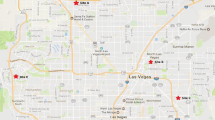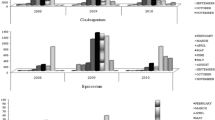Abstract
This study determined annual and monthly fluctuations in concentration of 20 fungal genera. The selection of taxa was made based upon their high frequency in the air as well as their well-known allergenic properties. Air samples were collected using a spore trap of Hirst design at an urban site where the trap continuously worked throughout a 5-year survey. Weather data were acquired from a meteorological station co-located with the air sampler. Influence of several meteorological parameters was then examined to reveal species–environment interactions and the potential location of fungal spore sources within the urban area. The maximum monthly sum of mean daily spore concentration varied between genera, and the earliest peaks were recorded for Pleospora sp. in April and Ustilago sp. in June. However, the majority of investigated spore types occurred in the greatest concentrations between August and September. Out of the 20 studied taxa, the most dominant genus was Cladosporium sp., which exceeded an allergenic threshold of 3000 s m−3 40 times during very rainy years and twice as much during dry years. A Spearman’s rank test showed that statistically significant (p ≤ 0.05) relationships between spore concentration and weather parameters were mainly r s ≤ 0.50. Potential sources of spores at Worcester were likely to be localised outside the city area.




Similar content being viewed by others
References
Bousquet, J., van Cauwenberge, P., & Khaltaev, N. (2001). Allergic rhinitis and its impact on asthma. Journal of Allergy and Clinical Immunology, 108, S147–S334.
Comtois, P. (1998). Statistical analysis of aerobiological data. In P. Mandrioli, P. Comtois, & V. Levizzani (Eds.), Methods in aerobiology (pp. 217–251). Bologna: Pitagora Editrice.
Corden, J. M., & Millington, W. M. (2001). Long-term trends and seasonal variation in the aeroallergen Alternaria in Derby, UK. Aerobiologia, 17, 127–136.
D’Amato, G., & Spieksma, F. T. M. (1995). Aerobiologic and clinical aspects of mould allergy in Europe. Allergy, 50, 870–877.
Damialis, A., Vokou, D., Gioulekas, D., & Halley, J. M. (2015). Long-term trends in airborne fungal-spore concentrations: a comparison with pollen. Fungal Ecology, 13, 150–156.
Del Mar, Trigo M., Toro, F. J., Recio, M., & Cabezudo, B. (2000). A statistical approach to comparing the results from different aerobiological stations. Grana, 39(5), 252–258.
Denning, D. W., O’Driscoll, B. R., Hogaboam, C. M., Bowyer, P., & Niwen, R. M. (2006). The link between fungi and severe asthma: a summary of the evidence. European Respiratory Journal, 27, 615–626.
Desbois, N., Beguin, H., Ruck, G., Nere, J., & Nolard, N. (2006). Calendrier des spores fongiques de la Martinique. Journal of Medical Mycology, 16, 189–196.
Ellis, M. B. (1971). Dematiaceous hyphomycetes. London: The Eastern Press Ltd.
Floyer, J. (1745). Violent asthma after visiting a wine cellar. London: Innys and Parker.
Frankland, A. W., & Davies, R. R. (1965). Allergy to mold spores in England. Le Poumon et le coeur, 21, 11–31.
Frenguelli, G. (2003). Basic microscopy, calculating the field of view, scanning of slides, sources of error. Post Dermatol Alergol, 20, 227–229.
Galán, C., Smith, M., Thibaudon, M., Frenguelli, G., Oteros, J., Gehrig, R., et al. (2014). Pollen monitoring: minimum requirements and reproducibility of analysis. Aerobiologia, 30, 385–395.
Grant Smith, E. (1990). Sampling and identifying allergenic pollens and molds. An illustrated identification manual for air samplers. San Antonio: Blewstone Press.
Green, B. J., Sercombe, J. K., & Tovey, E. R. (2005). Fungal fragments and undocumented conidia function as new aeroallergen sources. Journal of Allergy and Clinical Immunology, 115, 1043–1048.
Heinzerling, L., Frew, A. J., Bindslev-Jensen, C., Bonini, S., Bousquet, J., Bresciani, M., et al. (2005). Standard skin prick testing and sensitization to inhalant allergen across Europe: a survey from the GA2LEN network. Allergy, 60, 1287–1300.
Hirst, J. (1952). An automatic volumetric spore trap. Annals of Applied Biology, 39, 257–265.
Hyde, H. A., & Williams, D. A. (1959). Air-borne allergens. Postgraduate Medical Journal, 35, 458–462.
Ianovici, N., & Tudorica, D. (2009). Aeromycoflora in outdoor environment of Timisoara city (Romania). Notulae Scientia Biologicae, 1(1), 21–28.
Jenkins, P. F., Mullins, J., Davies, B. H., & Williams, D. A. (1980). The possible role of aero-allergens in the epidemic of asthma deaths. Clinical and Experimental Allergy, 11, 611–620.
Kasprzyk, I. (2008). Co-occurrence of airborne allergenic pollen grains and fungal spores in Rzeszów, Poland (2000–2002). Acta Agrobotanica, 61(2), 65–73.
Kasprzyk, I., Rodinkova, V., Šaulienė, I., Ritenberga, O., et al. (2015). Air pollution by allergenic spores of the genus Alternaria in the air of central and eastern Europe. Environmental Science and Pollution Research International, 22(12), 9260–9274.
Kasprzyk, I., Rzepowska, B., & Wasylów, M. (2004). Fungal spores in the atmosphere of Rzeszów (South-East Poland). Annals of Agricultural and Environmental Medicine, 11, 285–289.
Khot, A., & Burn, R. (1984). Seasonal variation and time trends of deaths from asthma in England and Wales 1960–1982. BMJ, 289, 233–234.
Kurup, V. P., Shen, H.-D., & Banerjee, B. (2000). Respiratory fungal allergy. Microbes and Infection, 2, 1101–1110.
Kurup, V. P., Shen, H.-D., & Vijay, H. (2002). Immunobiology of fungal allergens. International Archives of Allergy and Immunology, 129, 181–188.
Lacey, J. (1981). The aerobiology of conidial fungi. In G. T. Cole & B. Kendrick (Eds.), Biology of conidial fungi (pp. 373–416). New York: Academic Press.
Lacey, J. (1991). Aggregation of spores and its effect on aerodynamic behaviour. Grana, 30, 437–445.
Lacey, M. E., & West, J. (2006). The air spora. A manual for catching and identifying airborne biological particles. Dordrecht: Springer.
Levetin, E., Horner, W. E., & Scott, J. A. (2015). Taxonomy of allergenic fungi. The Journal of Allergy and Clinical Immunology: In Practice,. doi:10.1016/j.jaip.2015.10.012.
MAARA (2004) Spore calendar. Available from: http://www.maara.org/2013-08-19-06-21-06/spore-calendar. Accessed on 3 Aug 2015.
Morrow Brown, H., & Jackson, F. A. (1978). Aerobiological studies based in Derby. II. Simultaneous pollen and spore sampling at eight sites within a 60 km radius. Clinical Allergy, 8, 599–609.
Nikkels, A. H., Terstegge, P., & Spieksma, F. T. M. (1996). Ten types of microscopically identifiable airborne fungal spores at Leiden, the Netherlands. Aerobiologia, 12, 107–112.
Nilsson, S., & Persson, S. (1981). Tree pollen spectra in the Stockholm region (Sweden), 1973–1980. Grana, 20(3), 179–182.
O’Connor, D. J., Sadyś, M., Skjøth, C. A., Healy, D. A., Kennedy, R., & Sodeau, J. R. (2014). Atmospheric concentrations of Alternaria, Cladosporium, Ganoderma and Didymella spores monitored in Cork (Ireland) and Worcester (England) during the summer of 2010. Aerobiologia, 30, 397–411.
Ogden, E. C., Raynor, G. S., Hayes, J. V., Lewis, D. M., et al. (1974). Manual for sampling airborne pollen. New York: Hafner Press.
Oteros, J., Galán, C., Alcazár, P., & Dominguez Vilches, E. (2013). Quality control in bio-monitoring networks, Spanish Aerobiology Network. Science of the Total Environment, 443, 559–565.
Rice, M. (2011). Worcestershire demographic report 2011 with South Worcestershire Appendix (pp. 1–21). Worcester: Worcestershire County Council.
Rossi, V., Bugiani, R., Giosué, S., & Natali, P. (2005). Patterns of airborne conidia of Stemphylium vesicarium, the causal agent of brown spot disease of pears, in relation to weather conditions. Aerobiologia, 21, 203–216.
Sadyś, M., Kennedy, R., & West, J. S. (2015a). Possible scenarios of climate change impact on fungi: Analysis of 2 years of contrasting weather in the UK. Aerobiologia,. doi:10.1007/s10453-015-9402-6.
Sadyś, M., Skjøth, C. A., & Kennedy, R. (2014). Back-trajectories show export of airborne fungal spores (Ganoderma sp.) from forests to agricultural and urban areas in England. Atmospheric Environment, 84, 88–99.
Sadyś, M., Skjøth, C. A., & Kennedy, R. (2015b). Forecasting methodologies for Ganoderma spore concentration using combined statistical approaches and model evaluations. International Journal of Biometeorology,. doi:10.1007/s00484-015-1045-3.
Sadyś, M., Skjøth, C. A., & Kennedy, R. (2015c). Determination of Alternaria spp. habitats using 7-day volumetric spore trap, Hybrid Single Particle Lagrangian Integrated Trajectory model and geographic information system. Urban Climate, 14, 429–440.
Sadyś, M., Strzelczak, A., Grinn-Gofroń, A., & Kennedy, R. (2015d). Application of redundancy analysis for aerobiological data. International Journal of Biometeorology, 59, 25–36.
Simon-Nobbe, B., Denk, U., Pöll, V., & Rid, R. (2008). The spectrum of fungal allergy. International Archives of Allergy and Immunology, 145, 58–86.
Skjøth, C. A., Damialis, A., Belmonte, J., De Linares, C., Fernández Rodríguez, S., Grinn-Gofroń, A., et al. (2015). Alternaria spores in the air across Europe: Abundance, seasonality and relationships with climate, meteorology and local environment. Aerobiologia,. doi:10.1007/s10453-016-9426-6.
Skjøth, C. A., Sommer, J., Frederiksen, L., & Karlson, U. G. (2012). Crop harvest in Denmark and Central Europe contributes to the local load of airborne Alternaria spore concentrations in Copenhagen. Atmospheric Chemistry and Physics, 12, 11107–11123.
Stępalska, D., & Wołek, J. (2009). The estimation of fungal spore concentrations using two counting methods. Acta Agrobotanica, 62, 117–123.
Sterling, M., Rogers, C., & Levetin, E. (1999). An evaluation of two methods used for microscopic analysis of airborne fungal spore concentrations from the Burkard Spore Trap. Aerobiologia, 15(1), 9–18.
Twaroch, T. E., Curin, M., Valenta, R., & Swoboda, I. (2015). Mold allergens in respiratory allergy: from structure to therapy. Allergy, Asthma & Immunology Research, 7(3), 205–220.
Acknowledgments
This study was jointly funded by the National Pollen and Aerobiology Research Unit and Graduate Research School at the University of Worcester and conducted within a framework of the doctoral studies of the first author.
Author information
Authors and Affiliations
Corresponding author
Electronic supplementary material
Below is the link to the electronic supplementary material.
Rights and permissions
About this article
Cite this article
Sadyś, M., Adams-Groom, B., Herbert, R.J. et al. Comparisons of fungal spore distributions using air sampling at Worcester, England (2006–2010). Aerobiologia 32, 619–634 (2016). https://doi.org/10.1007/s10453-016-9436-4
Received:
Accepted:
Published:
Issue Date:
DOI: https://doi.org/10.1007/s10453-016-9436-4




